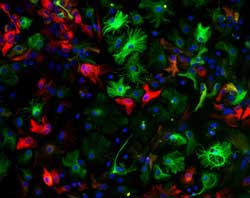Control by the matrix: RUB researchers decipher the role of proteins in the cell environment

Under suitable conditions, precursor cells in the nervous system (red) transform into other cell types, e.g. astrocytes (green). A fluorescence microscope image of a precursor cell culture is shown in which all cell nuclei are stained blue<br>Illustration: Dr. Michael Karus<br>
How astrocytes, certain cells of the nervous system, are generated was largely unknown up to now. Bochum’s researchers have now investigated what influence the cell environment, known as the extracellular matrix, has on this process.
They found out that the matrix protein tenascin C has to be present in order for astrocytes to multiply and distribute in a controlled fashion in the spinal cord of mice. Together with colleagues from the RWTH Aachen, the scientists from RUB Department of Cell Morphology and Molecular Neurobiology report their findings in the journal Development.
Tenascin C regulates astrocyte development
Immature astrocytes produce tenascin C and secrete it into the extracellular matrix. From there, it controls the development of the cells. To characterise the role of the protein more precisely, the Bochum team lead by Prof. Dr. Andreas Faissner, Prof. Dr. Stefan Wiese and Dr. Michael Karus analysed astrocytes that were genetically manipulated so that they did not produce tenascin C. The scientists observed that the astrocytes without the protein divided for a longer period of time, and migrated later to their destination in the spinal cord. “As a consequence of the longer cell division phase, we found an increased number of mature astrocytes” explained Karus.
Gene activity altered
Also at the molecular level, the tenascin C manipulation leaves its mark. With colleagues at the RWTH Aachen, Bochum’s researchers compared the gene activity in the spinal cord with and without tenascin C production. The absence of the protein not only affected genes that are typical of astrocytes. The scientists also documented expression level changes of genes that play a role for specific growth factors. These have an influence, for example, on the survival and division activity of different cell types.
Results also interesting for medical applications
Astrocytes take on a variety of tasks in the nervous system. They regulate the ion balance and the concentration of neurotransmitters, are part of the blood-brain barrier, and influence the activity of the nerve cells. In case of injuries to the central nervous system, or brain tumours, they form what are known as reactive astrocytes, which behave similarly to immature astrocytes. “So far, the function of tenascin C under such pathological conditions is largely unknown” said Karus. “However, if we find out more about the role of tenascin C during development, we will probably be able to better understand what affect it has, for example in spinal cord injuries.”
Bibliographic record
M. Karus, B. Denecke, C. ffrench-Constant, S. Wiese, A. Faissner (2011): The extracellular matrix molecule tenascin C modulates expression levels and territories of key patterning genes during spinal cord astrocyte specification, Development, doi: 10.1242/dev.067413
Further information
Dr. Michael Karus, Department of Cell Morphology and Molecular Neurobiology, Faculty of Biology and Biotechnology at the Ruhr-Universität, 44780 Bochum, Tel.: +49/234/32-24312
Michael.Karus@ruhr-uni-bochum.de
Click for more
Department of Cell Morphology and Molecular Neurobiology
http://dbs-lin.ruhr-uni-bochum.de/cellmorphology/index.php?&language=en
Editor
Dr. Julia Weiler
Media Contact
More Information:
http://www.ruhr-uni-bochum.deAll latest news from the category: Life Sciences and Chemistry
Articles and reports from the Life Sciences and chemistry area deal with applied and basic research into modern biology, chemistry and human medicine.
Valuable information can be found on a range of life sciences fields including bacteriology, biochemistry, bionics, bioinformatics, biophysics, biotechnology, genetics, geobotany, human biology, marine biology, microbiology, molecular biology, cellular biology, zoology, bioinorganic chemistry, microchemistry and environmental chemistry.
Newest articles

Zap Energy achieves 37-million-degree temperatures in a compact device
New publication reports record electron temperatures for a small-scale, sheared-flow-stabilized Z-pinch fusion device. In the nine decades since humans first produced fusion reactions, only a few fusion technologies have demonstrated…

Innovative microscopy demystifies metabolism of Alzheimer’s
Researchers at UC San Diego have deployed state-of-the art imaging techniques to discover the metabolism driving Alzheimer’s disease; results suggest new treatment strategies. Alzheimer’s disease causes significant problems with memory,…

A cause of immunodeficiency identified
After stroke and heart attack: Every year, between 250,000 and 300,000 people in Germany suffer from a stroke or heart attack. These patients suffer immune disturbances and are very frequently…





















